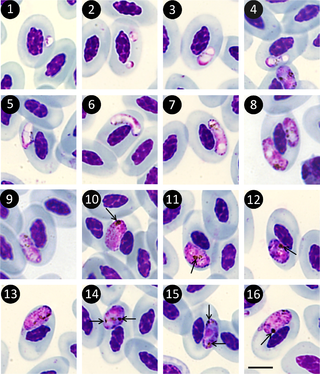
Plasmodium is a genus of unicellular eukaryotes that are obligate parasites of vertebrates and insects. The life cycles of Plasmodium species involve development in a blood-feeding insect host which then injects parasites into a vertebrate host during a blood meal. Parasites grow within a vertebrate body tissue before entering the bloodstream to infect red blood cells. The ensuing destruction of host red blood cells can result in malaria. During this infection, some parasites are picked up by a blood-feeding insect, continuing the life cycle.

The red-billed leiothrix is a member of the family Leiothrichidae, native to southern China and the Himalayas. Adults have bright red bills and a dull yellow ring around their eyes. Their backs are dull olive green, and they have a bright yellow-orange throat with a yellow chin; females are somewhat duller than males, and juveniles have black bills. It has also been introduced in various parts of the world, with small populations of escapees having existed in Japan since the 1980s. It has become a common cagebird and amongst aviculturists it goes by various names: Pekin robin, Pekin nightingale, Japanese nightingale, and Japanese (hill) robin, the last two being misnomers as it is not native to Japan.
Novyella is a subgenus of the genus Plasmodium - all of which are parasites. The subgenus was created in 1963 by Corradetti et al. Species in this subgenus infect birds. It unites the avian malaria parasites with small erythrocytic meronts and elongated gametocytes.
Plasmodium ashfordi is a species of the genus Plasmodium subgenus Papernaia.
Plasmodium paranucleophilum is a parasite of the genus Plasmodium subgenus Novyella. As in all Plasmodium species, P. paranucleophilum has both vertebrate and insect hosts. The vertebrate hosts for this parasite are birds.
Plasmodium bambusicolai is a species of the genus Plasmodium subgenus Novyella.
Plasmodium bertii is a parasite of the genus Plasmodium subgenus Papernaia.
Plasmodium papernai is a parasite of the genus Plasmodium subgenus Novyella. As in all Plasmodium species, P. papernai has both vertebrate and insect hosts. The vertebrate hosts for this parasite are birds.
Plasmodium jiangi is a parasite of the genus Plasmodium subgenus Novyella. As in all Plasmodium species, P. jiangi has both vertebrate and insect hosts. The vertebrate hosts for this parasite are birds.
Plasmodium globularis is a parasite of the genus Plasmodium subgenus Novyella. As in all Plasmodium species, P. globularis has both vertebrate and insect hosts. The vertebrate hosts for this parasite are birds.
Plasmodium megaglobularis is a species of malaria-causing parasite in the genus Plasmodium, subgenus Novyella. As in all Plasmodium species, P. megaglobularis has both vertebrate and insect hosts. The vertebrate hosts for this parasite are birds.
Plasmodium lucens is a parasite of the genus Plasmodium subgenus Novyella. As in all Plasmodium species, P. lucens has both vertebrate and insect hosts. The vertebrate hosts for this parasite are birds.
Plasmodium parahexamerium is a parasite of the genus Plasmodium, in the subgenus Novyella. As in all Plasmodium species, P. parahexamerium has both vertebrate and insect hosts. The vertebrate hosts for this parasite are birds.

The Haemosporida are an order of intraerythrocytic parasitic alveolates.
Plasmodium vaughani is a parasite of the genus Plasmodium, and the type species of the subgenus Novyella. As in all Plasmodium species, P. vaughani has both vertebrate and insect hosts. The vertebrate hosts for this parasite are birds.
Papernaia is a subgenus of the genus Plasmodium, all of which are parasitic protozoa. The subgenus was created in 2010 by Landau et al. It may be synonymous with Novyella.
Plasmodium unalis is a parasite of the genus Plasmodium subgenus Novyella. As in all Plasmodium species, P. unalis has both vertebrate and insect hosts. The vertebrate hosts for this parasite are birds.
Plasmodium delichoni is a parasite of the genus Plasmodium subgenus Novyella.


